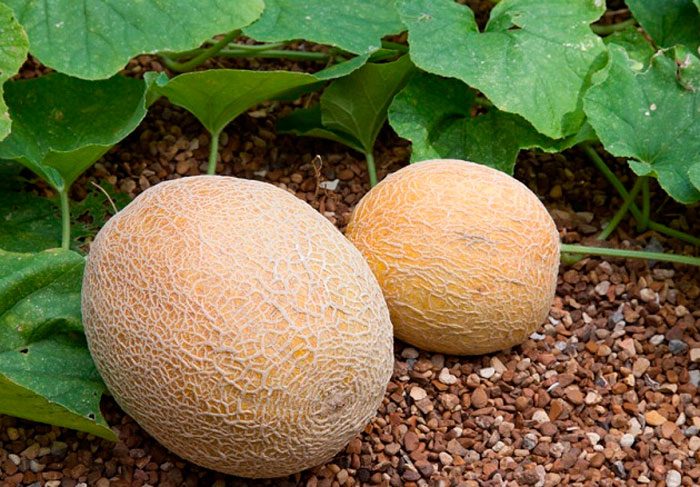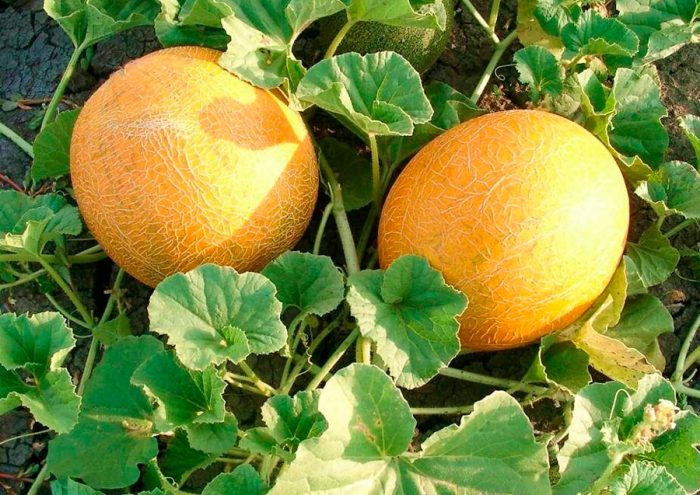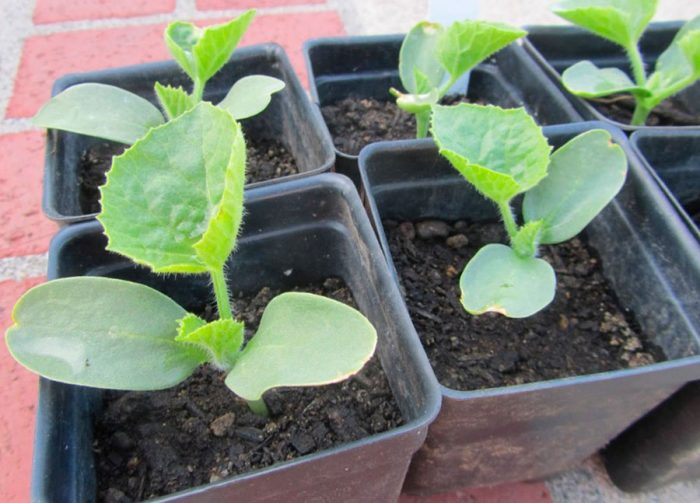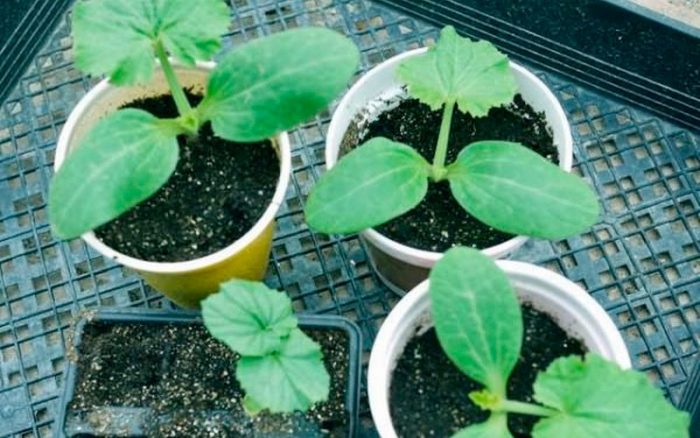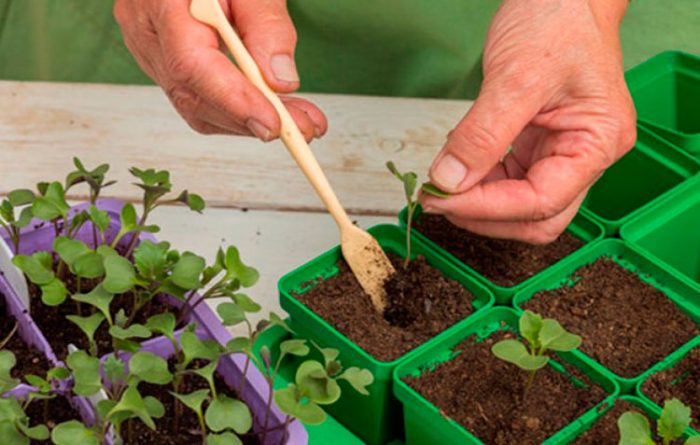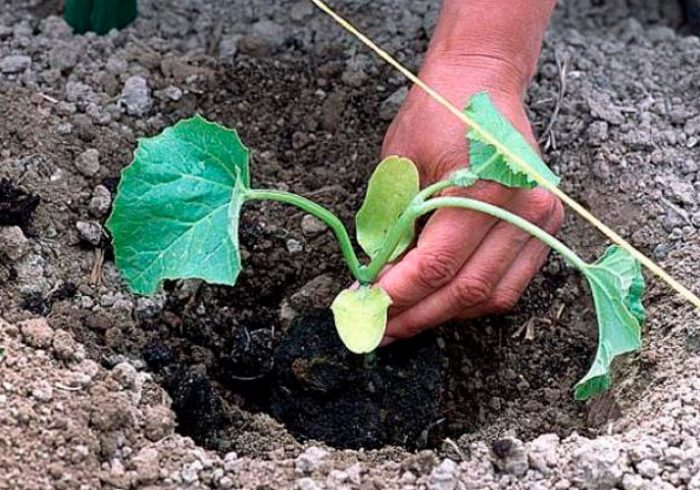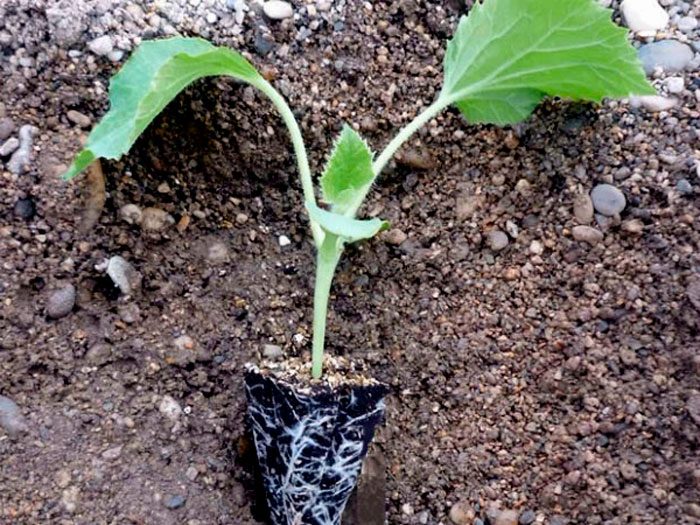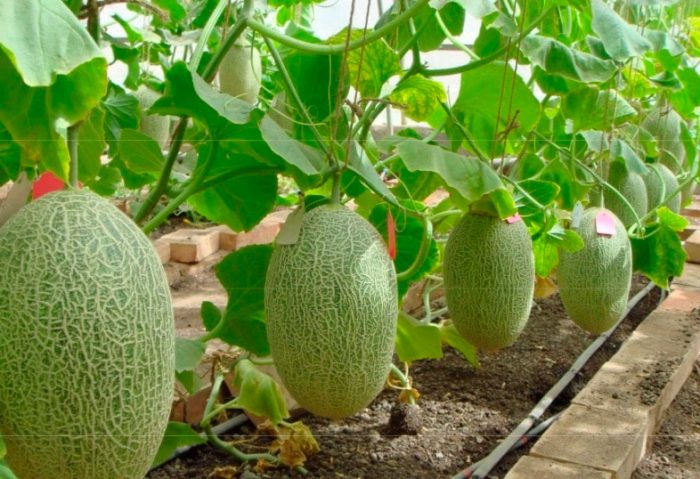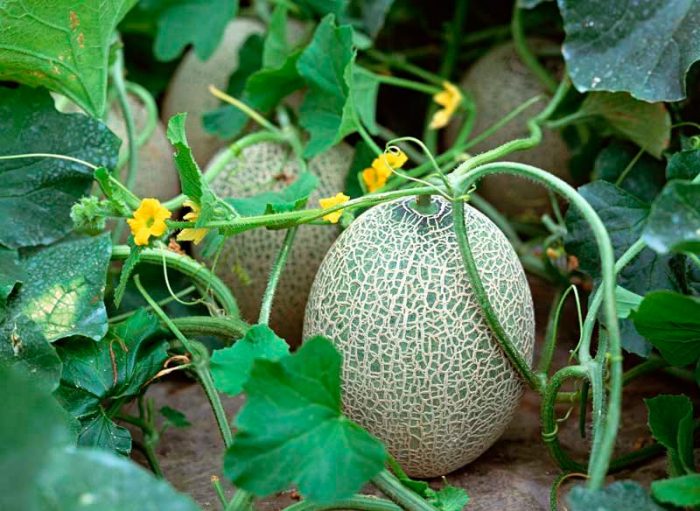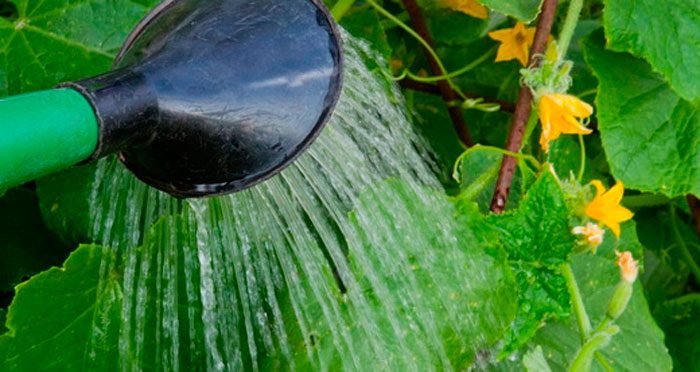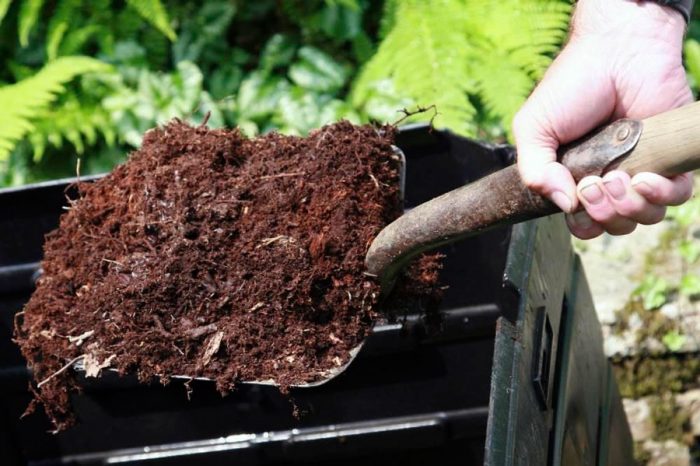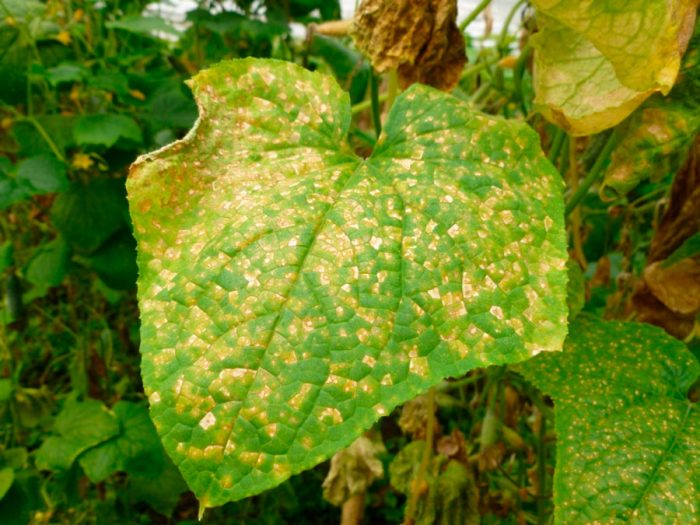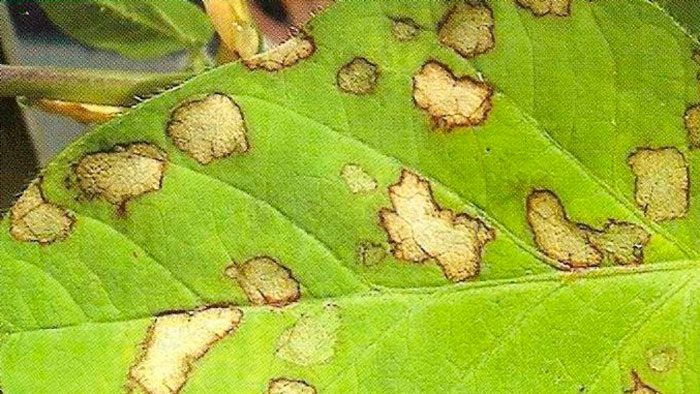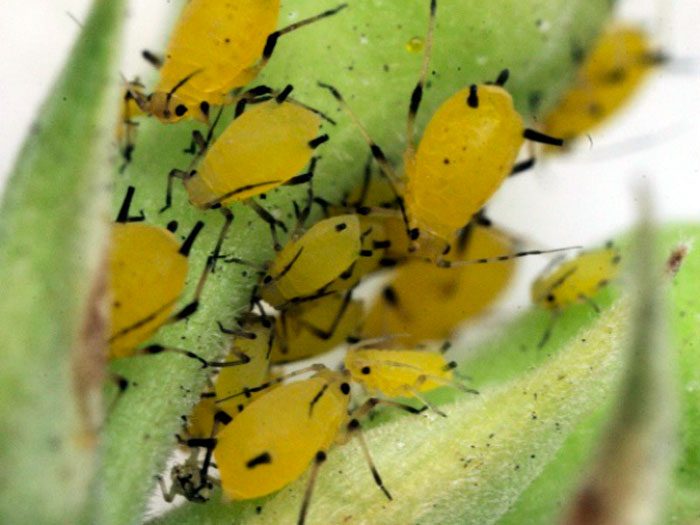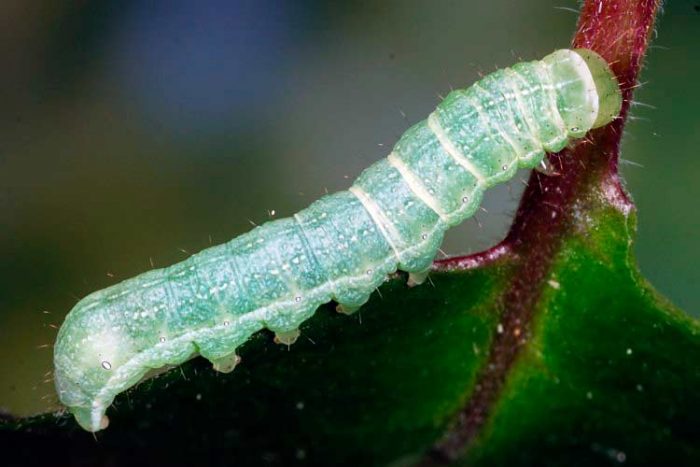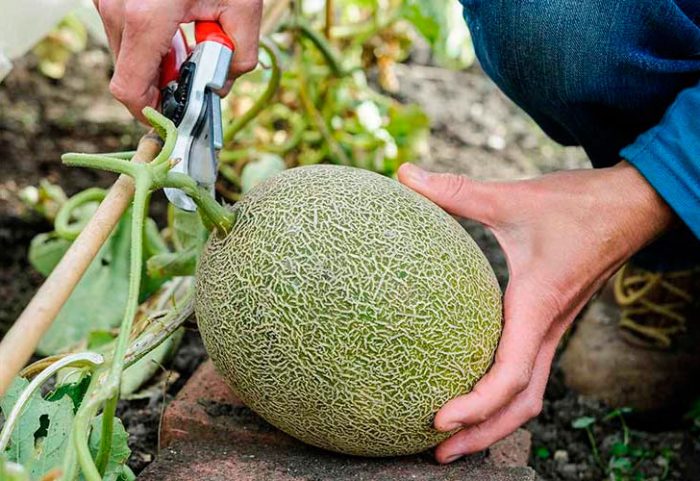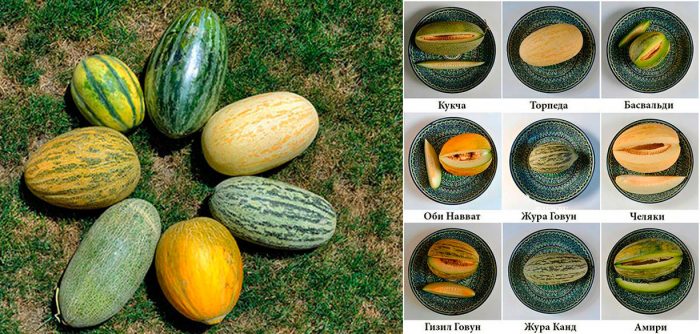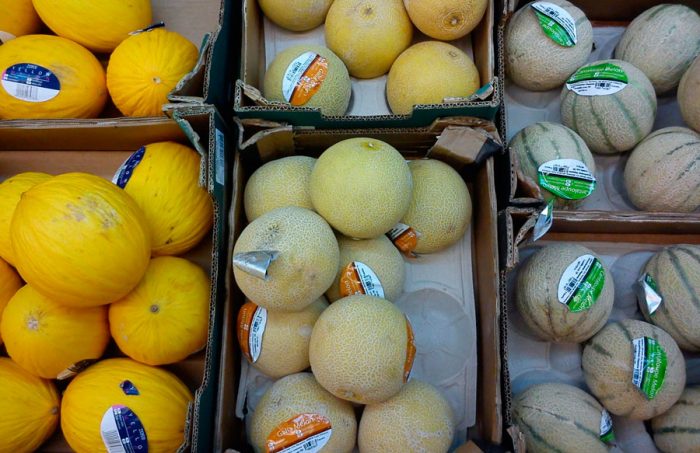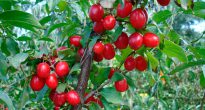Melon (Cucumis melo) is a melon crop, it is a species of the genus Cucumber of the Pumpkin family. Today, a melon growing in the wild is almost impossible to meet. Weed-field Asian species of melon served as material for breeding cultural forms of this plant. In the Bible, you can find the first mention of the melon, which was cultivated already in ancient Egypt. The homeland of this plant is Asia Minor and Central. In Northern India, as well as in the adjacent regions of Iran and Central Asia, the cultivation of this plant began several centuries before our era. Then the melon was observed to spread both westward and eastward (up to China). This melon culture was brought to the territory of Europe in the Middle Ages, and it came to Russia in the 15-16th centuries, while its cultivation first began in the Lower Volga region.
Content
Melon features
The melon is an annual that has a creeping shoot, reaching a length of 150-300 cm. The composition of the whole large palmate-lobed heart-shaped leaf plates includes 5 lobes. Unisexual flowers are yellowish. On one bush, 2–8 fruits (pumpkins) can form, which smell very nice. The shape of the fruit can be flattened, cylindrical or rounded, and they are colored brownish, white, green or yellow, with green stripes most often located on the surface. The color of the pulp is light green, yellow, white or orange. The duration of the melon growing season is 2.5–6 months.
Growing melons from seeds
Sowing
In the middle latitudes, this culture is grown through seedlings. For sowing, you need to use sowing material that was collected 3 or 4 years ago, but if you take freshly harvested seeds for this, then strong bushes with many male flowers will flaunt on the site, while there will be no fruits on them. Seeds need pre-sowing preparation. Large seeds need to be kept in a solution of potassium manganese (2%) for a third of an hour; for its preparation, 1.5 tbsp. combine water with 1 tsp. (no slide) potassium permanganate. It is also recommended to immerse the seed in a solution of zinc sulfate and boric acid (5%) for 12 hours, then the seeds are washed and dried.Some gardeners cold harden the seeds before sowing. To do this, they need to be kept in a thermos with water for a couple of hours, the temperature of which is about 30 degrees, after which they are taken out and covered with moistened gauze on top, and left for 24 hours at a temperature of 15 to 20 degrees. Then they are removed for 18 hours on a refrigerator shelf with a temperature of 0-2 degrees, after which they are again kept for 6 hours at a temperature of 15 to 20 degrees. The seeds hardened in this way are immediately sown in open soil.
In mid-April, seeds are sown for seedlings. For this, peat pots are used, reaching 10 centimeters in diameter, 2 or 3 seeds are sown in each of them, and they are buried by 15–20 mm. For growing seedlings, a substrate is used, which includes sand and peat (1: 9). 10 liters of the resulting substrate must be combined with 1 tbsp. wood ash.
Growing melon seedlings
Before the seedlings appear, crops must be kept at a temperature of no more than 18 degrees at night, and about 20-25 degrees during the day. About 7 days after sowing, the first seedlings should appear. Thinning will be required, for this, one of the most developed and strong plants must be left in each pot, the rest must be carefully cut off at the level of the substrate surface, it is not recommended to pull them out, since in this case there is a high probability of injury to the remaining seedling. When the plants have 3 pairs of true leaf plates, they should be pinched, due to which the active growth of lateral shoots will begin. Seedlings must be kept on the windowsill of the southern window; in the absence of this opportunity, it will need daily artificial supplementary lighting for 10-12 hours, while fluorescent lamps are used. Water the seedlings as needed and use lukewarm water for this. It should be borne in mind that after the seeds are sown, they must be watered for the first time only when 1 true leaf plate is formed in the seedlings. Make sure that no liquid gets on the shoots or foliage of the plants during watering. In order to prevent the development of the black leg, it is recommended to sprinkle the surface of the substrate with a layer of dry sand. Experts advise that seedlings should be fed 2 times using a solution of complex mineral fertilizer. Hardening of seedlings begins 7 days before planting them in open soil. To do this, the daytime temperature must be reduced to 15-17 degrees, and the nighttime temperature - to 12-15 degrees, while the duration of the hardening procedure must be increased gradually.


Watch this video on YouTube
Picking
Melon seedlings, like any other representatives of the Pumpkin family, do not dive, as they react extremely negatively to this procedure. In this regard, the sowing of seeds must be carried out in individual cups.
Planting melons outdoors
What time to plant
It is possible to plant melon seedlings in open soil only when the plants are 4 to 5 weeks old, while they must have 5 or 6 true leaf plates. However, experienced gardeners recommend waiting until the returnable spring frosts are left behind, and only then start planting melons in the open ground. If there is a threat of frost, but the melons have already been planted in open soil, then they need to be covered with a film on top.
This plant belongs to the thermophilic, therefore, for planting it, you should choose a well-lit and heated area that has reliable protection from the cold wind. It is very good if the melons grow on the south side of the garden. This crop grows very well after black steam, and the best predecessors are: corn, cucumbers, garlic, cabbage, winter wheat, barley, onions and legumes. It is not recommended to plant a melon on the same plot for two years in a row.Tomatoes and carrots are considered the worst predecessors of this culture. Beans, Swiss chard, sorrel, corn, turnips, basil, radishes and radishes can be grown in the vicinity of the melon. And you can't grow cucumbers and potatoes in the neighborhood.
Suitable soil
The soil should be light and neutral, but rich in organic matter. Melon will be able to grow in salty or dry soil, but it will die on wet and acidic soil. This crop grows best on medium loamy light soil, while heavy loam or sandy soil is not suitable for this purpose.
Before planting seedlings, the soil on the site must be prepared. To do this, in the autumn, it is necessary to add from 4 to 5 kilograms of manure or humus per 1 m to the soil for digging to the depth of a shovel bayonet2... In this case, it is still necessary to add ½ bucket of sand per 1 square meter of land to the clay soil. In spring, the site should be buried, while 35 to 45 grams of superphosphate and 15 to 25 grams of potassium salt are added to the soil per 1 square meter. Before the direct planting of seedlings, the site must be dug again, while nitrogen-containing fertilizers from 15 to 25 grams per 1 square meter are introduced into the ground.


Watch this video on YouTube
Open ground planting rules
To begin with, planting pits should be prepared on the site, the distance between them should be at least 0.6 m. Before planting, the seedlings must be watered very well, which will allow you to easily pull the plant out of the cups. The row spacing should be about 0.7 m. When planting plants, you should pay attention to the fact that their root collar rises above the surface of the soil, otherwise it can be affected by a fungal disease or rot will form on it. With this method of planting, it turns out that the melon seems to be placed on a tubercle. In order to prevent fungal diseases, when the seedlings are planted, the soil surface on the site will need to be covered with a layer of river sand. For the first 2 days, the planted plants will need protection from direct sunlight; for this, use wet paper.
Growing melon in a greenhouse
Melon in the greenhouse is grown on trellises, which saves space. Seedlings are planted in holes 70x50 centimeters in size, while a distance of 20 centimeters must be kept between the bushes. Planting is carried out at the same time as transplanting seedlings into open soil. Care for melon seedlings, as well as the procedure for hardening it, are described in detail above. Melons, tomatoes and peppers can be grown in the same greenhouse at the same time. However, melons, zucchini and cucumbers are best not planted together. In the prepared planting holes, immediately before planting, you need to add one and a half kilograms of compost or humus, on top of it you need to fill it with a layer of soil three centimeters thick, after which lukewarm water is poured into the hole. Then it is necessary to plant a melon in it along with a lump of earth by transshipment, while it should rise 15-30 mm above the garden bed, otherwise rot may appear on the hypocotal knee. In case of frost, the plants will need to be protected by erecting additional frames with a film for this.
During the first 7 days after planting the seedlings on the garden bed, in the case when it gets hotter than 30 degrees in the greenhouse, it must be ventilated. After 1-1.5 weeks after planting, under each bush, pour a couple of liters of lukewarm water, into which nitrogen-containing fertilizers must be added (for 1 bucket of water, 20 grams of ammonium nitrate). Watering should be done once a week, however, during the ripening of the fruit, the frequency of watering should be gradually reduced until it stops completely for 7-15 days until the melons are fully ripe. As a result, the fruit will be much sweeter.
It is necessary to feed the plants 2 times at intervals of 15–20 days, using organic fertilizers.In this case, you need to alternate feeding with herbal infusion and infusion of mullein, chicken droppings or humus, while under each plant you need to pour one handful of wood ash.
When 7 days have passed since the melons are planted in the greenhouse, the plants should be pinched over 5 or 6 leaf plates, after which they will have to grow side lashes with female flowers. Choose 2 of the most powerful lashes to tie to the trellis, and the rest to be cut off. As these lashes grow, they should be wrapped around the twine on the trellis, because they will not be able to climb it on their own. If there are not enough pollinating insects in the greenhouse, the plant will have to be manually pollinated. Take a brush and collect pollen from a male flower (it does not have an ovary), after which it is transferred to the pistil of a female flower. After melons are formed on the bushes, two or three pieces should be left on each of them, and the excess must be cut off. When the size of the fruit reaches the size of a tennis ball, it must be placed in the net, which must be hung on the horizontal guide of the trellis.
In some cases, the bushes in the greenhouse can be affected by a fungal disease or pests (scoops, melon aphids or spider mites) settle on them. To get rid of pests, the bushes need to be sprayed with Fitoverm or Iskra-bio. The fight against various diseases will be described in detail below. As soon as the size and color of the melon becomes characteristic of this variety, it must be removed, while pay attention to the connection of the pumpkin with the lash, cracks should form on it.
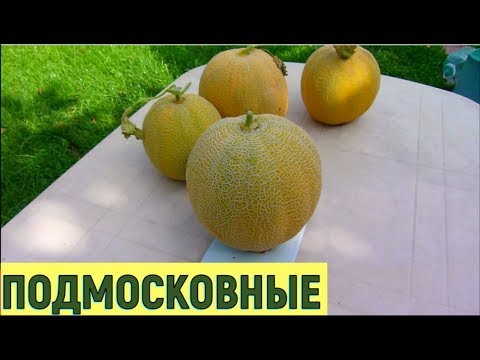

Watch this video on YouTube
Melon care
If the melon is grown in open soil, then it should be watered in a timely manner, loosened, weeded, spud, pinched, fed, and also be engaged in lashing. If necessary, artificial pollination is performed, this procedure is identical to that carried out when growing this crop in a greenhouse (see above).
After the seedlings planted in open soil take root and begin to grow actively, a secondary pinching of the main stem of each bush is performed. As a result, the bushes will not begin to increase the green mass, but will spend all their strength on the formation and growth of pumpkins. Over time, each bush should grow 2 side shoots and 1 main one, while all excess shoots must be cut off. They do differently with bushes of hybrid varieties, they have female flowers growing on the main shoot, in this regard, it cannot be pinched. In order to avoid thickening of the planting, in hybrid melons, the lateral shoots are pinched after the second or third leaf plate. Otherwise, care for the bushes of hybrid varieties should be the same as for plants of conventional varieties.
After the ovaries are formed on the bushes, all the extra ones must be cut off, leaving only 2–6 pieces on each, no more. When the pumpkins reach the size of a tennis ball, each of them is placed in an individual net, which must be tied to the trellis, this will relieve some of the load from the melon lashes. In order for the melons in the nets to ripen evenly, they should be periodically turned over. If the fruit lies on the surface of the soil, then it will be necessary to put a piece of non-rotting material under it, for example, roofing material or foil.
Please note that if only one pumpkin grows on a bush, while others turn yellow and develop incorrectly, then this can be corrected by feeding the plant. The first couple of times the soil surface between the rows must be loosened to a depth of 10 to 15 centimeters, then the depth of soil loosening must be reduced to 8–10 centimeters. The soil surface near the bushes must be loosened very carefully and not so deep. Hilling of plants is carried out after the beginning of the development of lateral lashes.After the leaves close, you need to stop loosening the soil surface near the plants.
Melons in the open field can be grown on a trellis, which is not only convenient, but also saves a lot of space. Install supports in advance, which should reach 200 cm in height. After the melons are planted in open soil, after a few days it will be necessary to tie the shoot with a rope, while its upper tip is fixed on the trellis. After a while, the garter of the lateral shoots is performed in the same way.
How to water
This culture needs systematic watering. On average, the bushes are watered once every 7 days. This is done in the morning using lukewarm (from 22 to 25 degrees) water, while making sure that no water gets on the shoots, flowers, foliage, buds or pumpkins. Experienced gardeners recommend making a groove around the bush, into which water should be poured. However, the most optimal method of irrigation for melons is drip. Do not allow water to stagnate in the soil, as this will cause rot on the root system of the bush. In this regard, before watering, it is imperative to check whether the topsoil on the garden bed is dry. To make the melons sweeter, after the pumpkin appears, watering should be gradually reduced until they completely stop.
Fertilizer
It is recommended to feed melons together with watering. After 15 days have passed after transplanting melons to the garden, it is recommended to feed them with a solution of ammonium nitrate (20 grams per 10 liters of water), while 2 liters of nutrient solution are poured under each bush. After the buds begin to form, the bushes need to be fed again with the same ammonium nitrate solution, or it can be replaced with a mullein solution (1:10). After 15–20 days, the plants must be fed with the following nutrient solution: for 1 bucket of water 50 grams of superphosphate, 30 grams of ammonium sulfate and 20 to 25 grams of potassium salt.


Watch this video on YouTube
Melon diseases and pests
Diseases
Any varieties of melons that are grown in the open field or in a greenhouse, if not properly looked after or violated the rules of agricultural technology of this crop, can be affected by viral, fungal, and bacterial diseases. And some pests can settle on the bushes. In order to preserve your harvest, it is necessary to timely identify the incipient diseases, as well as find settled pests. It is also important to start the treatment of diseased bushes in a timely manner.
Powdery mildew
This disease is fungal. In the affected bushes, whitish spots form on the foliage and shoots, which, as the disease progresses, spread over the entire surface of the plant and change their color to brown. The foliage tissue under such a bloom becomes more fragile, it is observed to dry out and fold. Stems grow more slowly, pumpkins begin to lag behind in development, and they also become less quality and the amount of sugar in them decreases. If symptoms of this disease are found on the bushes, then they must be treated with sulfur powder (80%), while 4 grams of the substance are taken per 1 square meter of the garden. If necessary, plantings can be processed several times, while an interval of 3 weeks should be maintained between procedures. At least 20 days before harvesting, you must stop any processing.
Downy mildew (downy mildew)
In diseased bushes, specks of green-yellow color are formed on the leaf plates. They grow rapidly and after a short time cover the entire surface of the leaf. If high humidity is observed for a rather long time, then a bloom of a violet-gray color appears on the seamy surface of the leaf plate, which contains spores of the fungus. For preventive purposes, one must not neglect the pre-sowing preparation of seeds.To do this, they are poured into a thermos filled with hot (about 45 degrees) water for 2 hours, after which they are immersed in a solution of potassium permanganate (1%) for a third of an hour. If diseased plants were found, then the entire area must be sprayed with a urea solution (10 grams of substance per 10 liters of water). If this method of combating the disease turns out to be low-effective, the melons should be treated with a solution of Oxychom or Topaz, and the instructions attached to the drug should be followed.
Fusarium wilting
It is also a fungal disease, its pathogens are in the soil, from which they get on the remains of plants or on the sowing material of the melon. Most often, this disease affects melons of late and mid-season varieties. In diseased bushes, a decrease in yield is observed, as well as a deterioration in the quality of pumpkins. Symptoms of this disease appear during the formation of the second or third true leaf plate or during the ripening of pumpkins. In affected bushes, the foliage becomes light, and many specks of gray color appear on its surface. Infected aerial parts begin to wilt, and after 1.5 weeks the plant completely dies. Affected plants during the formation of buds must be sprayed with a solution of potassium chloride. For prevention purposes, before sowing, the seeds must be kept in a formalin solution (40%) for 5 minutes.
Copperhead (anthracnose)
On the surface of the leaf plates, specks of a rounded shape and pale pink or brown color are formed. These spots become larger over time. Holes appear on the infected leaf plates, curling of the leaves and drying of the entire bush are also observed. Thinning of the lashes occurs, which become very fragile, and the pumpkins are deformed and rot appears on them. Infected melons should be sprayed with Bordeaux mixture (1%), while 3 or 4 procedures are required, which are carried out 1 time in 1.5 weeks. Instead, the entire area with melons can be pollinated with sulfur powder.
Ascochitosis
This disease is also fungal. In plants grown in greenhouses, after infection, areas of brown color appear on the shoots, over time they spread throughout the bush. The diseased bush dies as a result of damage to the root part. If signs of infection with this disease are found, then it is imperative to adjust the watering, significantly reducing it, and the infected areas of the melon should be powdered with a mixture of wood ash and lime, or bushes can be treated with Bordeaux mixture (1%). For preventive purposes, the inoculum must be disinfected before sowing; for this, use Silk or Immunocytophyte.
Root rot
Weakened plants are susceptible to this disease. It is noteworthy that in young specimens, the roots and stems first become brown, after which they become thinner, and the bush withers. In an adult plant, yellowing and wilting of the aerial part is also observed, and the roots and the lower part of the stem are painted brown. For prophylactic purposes, before sowing, the seed must be kept for 5 minutes in a formalin solution (40%).
Viral diseases
Cucumber Mosaic Virus, Specialty Virus and Watermelon Mosaic Virus. Their main carriers are aphids, in this regard, when this pest is found, you need to try to get rid of it as soon as possible. If the melon is affected by any of the listed diseases, then it must be removed from the ground and destroyed as soon as possible. The fact is that to date, no effective drug for viral diseases has been found. Signs of viral diseases: areas with a mosaic color are formed on the leaf plates, internodes are shortened, the bush is lagging behind in development, the foliage is deformed, the ovaries are crumbling, and specks appear on the surface of the pumpkins.
Pests
The following insects can harm this plant: spider mites, gnawing scoops, melon aphids and wireworms.
Melon aphid
Its accumulation is observed on the seamy surface of the sheet plates. Aphids suck out the juice from the bush, which causes drying and folding of foliage, while the flowers crumble without even having time to open. In addition, this pest is the main carrier of dangerous incurable diseases. To get rid of aphids, the bushes should be treated with Actellik (30%) or Karbofos (10%) solution.
Spider mites
This pest, just like aphids, settles on the seamy surface of the foliage. Ticks suck the juice out of the bush. These pests are the most dangerous for melons that are grown in a greenhouse, but they can also settle on melons and gourds. The affected bushes should be sprayed with a solution of Bicol, Fitoverm or Bitoxibacillin.
Wireworms
The wireworm is actually the larva of the click beetle. They damage the root system of the bushes, causing the melons to die. In order to prevent the reproduction of such a pest, in the autumn time the site will need a deep digging, it is also necessary to adhere to the rules of crop rotation.
Gnawing scoops
For the melon, caterpillars of the gnawing scoop are dangerous, which gnaw the stem of the bush, because of which it dies. To destroy the caterpillars, you will need to deeply dig the site, but only after the harvest has been harvested. For prevention purposes, it is imperative to adhere to the rules of crop rotation.
Melon processing
Bushes affected by a fungal disease are treated with fungicidal preparations, while at least 2-4 procedures are carried out. In the intervals between treatments, the use of preparations of contact properties is prohibited. It is also impossible to alternate fungicides from different chemical groups, you need to use either the same drug or its analogue. The duration of breaks between treatments should not exceed 12 days. After the melons have been treated with a systemic fungicide for the last time, you can use a contact agent only when 8-10 days have passed, not earlier. Experts advise using systemic fungicides to treat young bushes that grow and develop intensively. In this case, it is best to use contact preparations for processing adult specimens.


Watch this video on YouTube
Collection and storage of melons
Before you start harvesting your melon, you should make sure that the fruits are fully ripe. To do this, you need to check the color of the pumpkin, as well as inspect the network of cracks, which should be located on the surface of the peel. Ripe fruits, ready to be harvested, can be easily detached from the whip, a grid is located on their entire surface, while the pumpkin changes its color to yellow. But it should be noted that such melons are not intended for long-term storage, as a rule, they can lie no more than 8 weeks. Fruits that will be stored for a long time have a moderately pronounced net that covers only ½ of the pumpkin. The same fruits that are completely yellow, and there is a grid on their entire surface, should be used immediately for food. There are also varieties that do not form a mesh on the surface of the fruit, their degree of maturity is judged by color.
Keeping quality scale:
- low - these fruits are stored for no more than 14 days;
- small varieties - they can be stored from 2 to 4 weeks;
- medium varieties - the storage period for such melons is from 1 to 2 months;
- stable varieties - such fruits are stored for about three months;
- very hardy varieties - the shelf life of these fruits is more than three months.
Late as well as mid-season varieties produce fruits that can be stored for about 6 months if they are provided with optimal conditions.And mid-early, early and some mid-season varieties cannot be stored for a long time, in this regard, it is recommended not to store them, but to eat them immediately.
The fruits of late-ripening varieties, which can be stored for a long time, are removed from the garden in a state of technical maturity selectively, only after the necessary signs appear on the pumpkins. Melons should be plucked with a stalk, which should be up to 30 mm in length; they cannot be cut off. Fruit picking is carried out early in the morning or in the evening, in the heat of the day this cannot be done. After the pumpkin is plucked, it must be left for three to four days on the site, while it should be regularly turned over every 5-6 hours. Then they are laid in a storage that must be cool (not cold), be sure to pre-disinfect by treating with bleach. Also, smoke bombs can be used to disinfect the storage, which will exterminate pests and all viruses. When the room is processed, it should stand tightly closed for several days. After that, the store is very well ventilated, and then all structures made of wood must be whitewashed with freshly slaked lime. The fruits are placed in storage on shelves, while the surface of the shelves must be covered in advance with a layer of chaff or sawdust. You can also store the fruits in a suspended form, for this they are placed in individual coarse mesh, while they are hung on a rack with crossbars. In the storage room, the humidity should be approximately 80 percent, while the optimum temperature is 2-3 degrees. Melons should not be stored next to apples and potatoes. Because of the potatoes, the fruit has a not very pleasant aftertaste, and rot forms on them. And apples release ethylene, which makes the melons ripen much faster, which leads to their overripening. Do not forget to carry out a systematic inspection of the fruits, while those that have signs of spoilage must be removed.


Watch this video on YouTube
Types and varieties of melons
Melon (Melo) is a separate genus, which unites about 30 species, while 2 of them are wild. A small part of the species is found naturally in Africa and China, but most of the species grows in Afghanistan, Central Asia and Iran, while the first cultivated varieties of this plant appeared on the territory of these countries. Central Asian types of melon are the most delicious and fragrant, and the most popular of them are as follows:
- Zard... Chardzhou melon has a fusiform shape, it is colored green. It can grow up to 25 kilograms, while externally the pumpkin is similar to a huge cucumber. In September, the flesh of the fruit is tough and tasteless, but in the winter after it ripens, it becomes tender, fragrant and very sweet. The Gulabi variety is the most delicious, its fruits can be stored for up to 6 months.
- Khandalyak... This is an early look. The fruits are small and very tender, they have a pear flavor.
- Amery... Such Bukhara melons have an oval shape, their weight varies from 5 to 10 kilograms. The pulp is crispy and has a vanilla smell.
Asia Minor melons are also quite popular, but Central Asian melons have much higher taste. The most popular species of Asia Minor are the Cilician melon from Syria and the Kassaba from Turkey, which is almost odorless.
In cooler climates, European varieties of melons are grown, which are derived from Central Asian species. For example, there is a European variety of cantaloupe, named after the papal estate of Cantaluppia. She has ribbed (segmented) fruits that do not have outstanding taste, but this plant grows well and bears fruit even in England.
All European varieties are divided into:
- very early - they ripen after 60–70 days;
- summer - the fruits are large, there is a mesh on the surface of the entire rind, and the pulp is tender, fragrant and sweet;
- wintering - small fruits are bronze or dark green in color, on the surface of the peel there is a dense net, the pulp is dense, sweet and crunchy.
In mid-latitudes in the open field, it is recommended to grow the following hybrids and varieties:
- Blondie... The fruits ripen after 80–90 days. The fragrant and delicate pulp is colored deep orange. The light beige-gray rind is rather thin. Round, ribbed fruits are slightly flattened, they contain a large amount of sugar and carotene. Fruit weight - about 0.7 kg.
- Wintering... This late-ripening variety is poorly suited for mid-latitude cultivation. However, in warmer regions, pumpkins have enough time to ripen in 90 days. The fruits are light greenish-yellow in color, there are no stripes on the surface of the peel, but there is a coarse mesh. The greenish tender pulp is rather juicy. The fruits weigh about 2.5 kilograms.
- Altai... This variety was created in Siberia and is rather successfully cultivated here. Oval fruits have a thin peel, and their flesh is fragrant and tasty. Melons weigh no more than 1.5 kg.
- Pineapple... This variety is one of the earliest. The oval fruit is covered with a golden skin, on the surface of which there is a mesh. The sweet, fragrant pulp has a pinkish tint. The fruits weigh approximately 2 kilograms.
- Honey... This variety is cultivated in Morocco, as well as in the Mediterranean countries. Round or elongated smooth melons are green in color. The fragrant and sweet pulp is colored light yellow, green or red-yellow, it contains manganese, potassium and vitamin A.
- Galileo... This mid-early variety was created specifically for cultivation in the southern part of Russia. The mass of small fruits is about 1 kilogram; there is a dense net on the surface of the brownish peel. The pale green fragrant pulp has a delicate taste.
- Charente... This variety is obtained in France. In this varietal group, he has the smallest fruits, while they are the most delicious and fragrant. The fruit is very similar to cantaloupe. Slightly flattened pumpkins are round in shape, on the surface of the peel there are smooth longitudinally located grooves. The sweet orange pulp is very fragrant and low in calories, and it also contains a large amount of vitamins.
- Augen... This hybrid was created in Israel. Elongated melons have a slightly flattened shape, they are colored yellow, light green or greenish yellow, there are specks, longitudinal notches and stripes on the surface. The fragrant and sweet flesh is colored green.
- Story... This is an early variety. Yellow melons are elliptical in shape and weigh about 2 kilograms. There is no pattern on the peel, the mesh is sparse, and the segments are poorly expressed. The pale creamy sweet flesh has medium juiciness and moderate aroma.
- Moon... Medium early variety. The oval and smooth melons are yellow colored, have a delicate mesh and weigh about 1 kilogram. The creamy pulp has a pleasant aroma, as well as medium sweetness and juiciness.


Watch this video on YouTube

